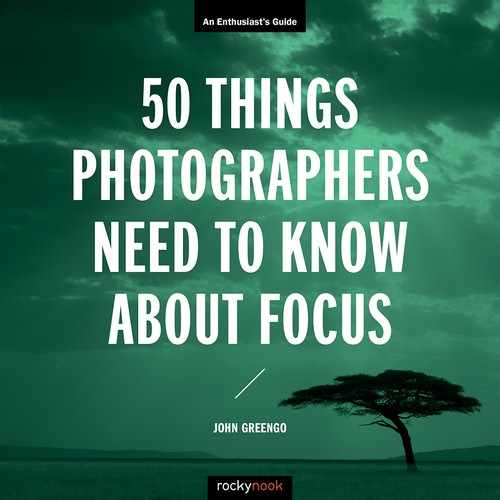47. IMAGE STABILIZATION
![]()
IN-CAMERA STABILIZATION is one of the all-time favorite advancements in the world of photography. Compensating for the photographer’s every movement, image stabilization lets us take in-focus, handheld shots at slow shutter speeds that would normally blur due to movement. There are many ways this technology has been applied to cameras and lenses, with a few key factors you should know about.
Image stabilization (it may be called something else, depending on the system that you use) consists of a gyro sensor in the camera or lens that tracks the movements made when you handhold the camera. It then moves either a group of lenses or the sensor to compensate for your movement so that the projected image on the sensor remains stationary.
Be aware that image stabilization does nothing to stop the motion of a subject you are photographing. The only way to freeze the action of a fast moving subject is by using a fast shutter speed. Image stabilization only compensates for the motion of the person holding the camera. Because of this, stabilization is not important in action photography, but can be very handy for landscapes, travel photography, architecture photography, or any static scene in low light.
There are two types of image stabilization: lens-based and sensor-based. The first products to hit the shelves were lenses that were marketed as having two stops of stabilization. This meant a sharp, handheld shot was possible at two stops below the normal minimum shutter speed. If we could normally handhold a lens at 1/60 second, stabilization would now allow us to shoot at 1/15 second. The latest generation of lenses are boasting up to seven stops of stabilization, which would allow us to shoot at 2 seconds with the same lens. The advantage of the lens-based systems is that the gyros, motors, and actuators can be tailored to specific focal lengths, which have different requirements for stabilization.
In-body image stabilization (IBIS) is a beloved feature of many photographers. The image sensor is mounted on a moving chassis that can adjust for changing motion in up to five directions: roll, pitch, yaw, X (up/down), and Y (left/right). The big advantage of IBIS is that it will work with all lenses, even if they are from a different manufacturer or of an older manual focus type. Some cameras with IBIS will allow you to enter the focal length of third-party lenses so that the stabilization system can be optimized for it.

Image stabilization in a camera or lens can compensate for movement in many different directions.

Some lenses will offer more than just the ability to turn stabilization on and off. This Canon lens has three distinct modes for stabilization.
Some cameras that have IBIS will also work with stabilized lenses that either share duties or combine for additional stabilization. The best of these can work up to 7 stops of stabilization, all the way down to shutter speeds of 2 full seconds.
Different modes of stabilization are available with certain brands. Some Canon lenses offer Mode 2, which aids during panning by detecting the direction of movement, and only stabilizing the vertical motions. Mode 3 is also for panning, but the stabilization only takes place during the moment of exposure—which might make tracking a fast-moving subject a bit easier.
Nikon calls their system Vibration Reduction and sometimes offers two modes: Normal and Active. The active setting is designed to compensate for vibrations from a moving vehicle or vessel.
Some cameras offer Digital Image Stabilization, which is completely different to the standard image stabilization and should not be used if you want maximum resolution. They achieve image stabilization by cropping the image, adjusting for movements by moving the recording area around on the sensor. This will result in a loss of resolution by a notable amount. This shouldn’t be used unless you are desperate for stability and are willing to sacrifice resolution for it.
Turning the stabilization system off when the camera is mounted to a tripod is recommended. If the camera is secured and not moving, there is no sense using stabilization because it can sometimes move during exposure and cause blur.
Image Stabilization Nomenclature
Canon: Image Stabilization
- Mode 1: Standard handheld camera
- Mode 2: Panning
- Mode 3: Panning, with stabilization only during exposure
Fujifilm: Optical Image Stabilization
Leica: Optical Image Stabilization
Nikon: Vibration Reduction
- Normal: Standard handheld camera
- Active: Shooting from a moving platform (car, train, boat)
- Sport: Panning
Olympus: Image Stabilization
- S-IS Auto: Camera detects panning
- S-IS1: Standard handheld camera
- S-IS2: Image stabilization only for vertical shake
- S-IS3: Image stabilization only for horizontal shake
Panasonic: Optical Image Stabilizer, In-Lens Stabilizer, In-Body Stabilizer, Dual I.S. Mode
Pentax: Shake Reduction
Sony: Optical SteadyShot Image Stabilization
- Mode 1: Standard handheld camera
- Mode 2: Panning
- Mode 3: Action tracking
